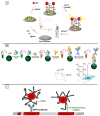Recent Advances in Biosensors for Diagnosis of Autoimmune Diseases
- PMID: 38475046
- PMCID: PMC10934086
- DOI: 10.3390/s24051510
Recent Advances in Biosensors for Diagnosis of Autoimmune Diseases
Abstract
Over the last decade, autoimmune diseases (ADs) have undergone a significant increase because of genetic and/or environmental factors; therefore, their simple and fast diagnosis is of high importance. The conventional diagnostic techniques for ADs require tedious sample preparation, sophisticated instruments, a dedicated laboratory, and qualified personnel. For these reasons, biosensors could represent a useful alternative to these methods. Biosensors are considered to be promising tools that can be used in clinical analysis for an early diagnosis due to their high sensitivity, simplicity, low cost, possible miniaturization (POCT), and potential ability for real-time analysis. In this review, recently developed biosensors for the detection of autoimmune disease biomarkers are discussed. In the first part, we focus on the main AD biomarkers and the current methods of their detection. Then, we discuss the principles and different types of biosensors. Finally, we overview the characteristics of biosensors based on different bioreceptors reported in the literature.
Keywords: autoimmune disease; biomarkers; biosensors; diagnosis.
Conflict of interest statement
The authors declare no conflicts of interest.
Figures





Similar articles
-
Electrochemical Biosensors as Potential Diagnostic Devices for Autoimmune Diseases.Biosensors (Basel). 2019 Mar 4;9(1):38. doi: 10.3390/bios9010038. Biosensors (Basel). 2019. PMID: 30836674 Free PMC article. Review.
-
Recent progress in electrochemical biosensors as point of care diagnostics in livestock health.Anal Biochem. 2019 Aug 15;579:25-34. doi: 10.1016/j.ab.2019.05.014. Epub 2019 May 23. Anal Biochem. 2019. PMID: 31128087 Review.
-
Biosensors for autoimmune diseases.Clin Chim Acta. 2025 Jan 15;565:119998. doi: 10.1016/j.cca.2024.119998. Epub 2024 Oct 24. Clin Chim Acta. 2025. PMID: 39454986 Review.
-
Advances in Nanoporous Anodic Alumina-Based Biosensors to Detect Biomarkers of Clinical Significance: A Review.Adv Healthc Mater. 2018 Mar;7(5). doi: 10.1002/adhm.201700904. Epub 2017 Dec 5. Adv Healthc Mater. 2018. PMID: 29205934 Review.
-
Recent advances in biosensors detecting biomarkers from exhaled breath and saliva for respiratory disease diagnosis.Biosens Bioelectron. 2025 Jan 1;267:116820. doi: 10.1016/j.bios.2024.116820. Epub 2024 Sep 29. Biosens Bioelectron. 2025. PMID: 39374569 Review.
Cited by
-
Sensing the Future-Frontiers in Biosensors: Exploring Classifications, Principles, and Recent Advances.ACS Omega. 2024 Dec 6;9(50):48918-48987. doi: 10.1021/acsomega.4c07991. eCollection 2024 Dec 17. ACS Omega. 2024. PMID: 39713646 Free PMC article. Review.
-
Identification of Plasma Metabolomic Biomarkers of Juvenile Idiopathic Arthritis.Metabolites. 2024 Sep 16;14(9):499. doi: 10.3390/metabo14090499. Metabolites. 2024. PMID: 39330506 Free PMC article.
References
-
- Alegria G.C., Guellec D., Mariette X., Gottenberg J.E., Dernis E., Dubost J.J., Trouvin A.P., Hachulla E., Larroche C., Le Guern V., et al. Epidemiology of neurological manifestations in Sjögren’s syndrome: Data from the French ASSESS Cohort. RMD Open. 2016;2:e000179. doi: 10.1136/rmdopen-2015-000179. - DOI - PMC - PubMed
Publication types
MeSH terms
Substances
LinkOut - more resources
Full Text Sources
Medical

